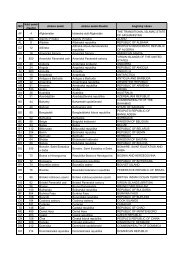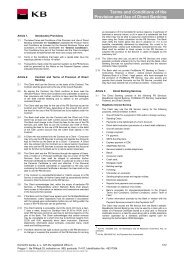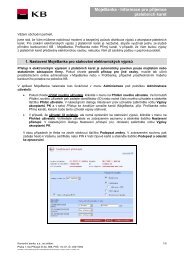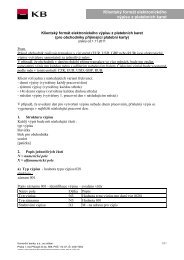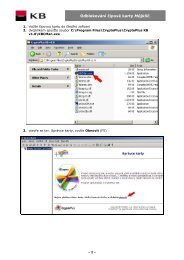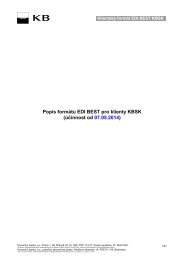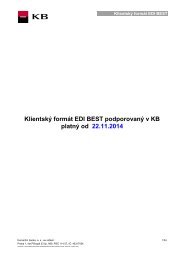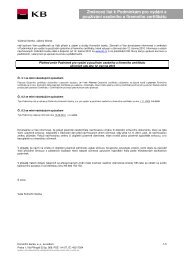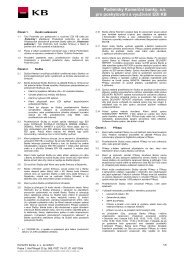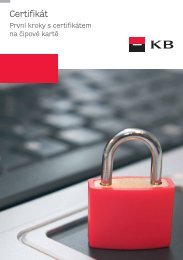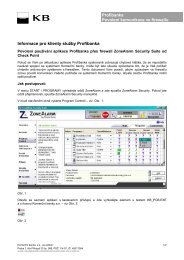Certification policy for subordinate CA KB (PDF file) - Komerční banka
Certification policy for subordinate CA KB (PDF file) - Komerční banka
Certification policy for subordinate CA KB (PDF file) - Komerční banka
Create successful ePaper yourself
Turn your PDF publications into a flip-book with our unique Google optimized e-Paper software.
kSubordinate certification authoritycetification <strong>policy</strong>Public key infrastructure (PKI)in <strong>Komerční</strong> <strong>banka</strong><strong>Certification</strong> <strong>policy</strong> (CP)<strong>for</strong> aSubordinate certification authority of <strong>Komerční</strong> <strong>banka</strong>Subordinate certification authority certification <strong>policy</strong>.doc 1
Contents1 INTRODUCTION ............................................................................................................ 51.1 TERMS USED................................................................................................................... 51.2 ABBREVIATIONS ............................................................................................................. 51.3 IDENTIFI<strong>CA</strong>TION ............................................................................................................. 51.4 APPLI<strong>CA</strong>BILITY ............................................................................................................... 61.4.1 <strong>Certification</strong> authority ............................................................................................ 61.4.2 Registration authority ............................................................................................ 61.4.3 Inappropriate use ................................................................................................... 62 CONTACTS ...................................................................................................................... 62.1.1 Contact persons ...................................................................................................... 62.1.2 Administration and management ........................................................................... 62.1.3 Departments responsible <strong>for</strong> CP in <strong>KB</strong> .................................................................. 63 GENERAL PROVISIONS .............................................................................................. 63.1 RIGHTS, DUTIES AND COMMITMENTS .............................................................................. 63.1.1 <strong>KB</strong> ........................................................................................................................... 63.1.2 PKI administration ................................................................................................. 63.1.3 Administration of certificates and public services of <strong>KB</strong> (SC <strong>KB</strong>) ......................... 63.2 GUARANTEES ................................................................................................................. 73.3 LIABILITY FOR DAMAGE ................................................................................................. 73.4 INTERPRETATION AND ENFORCEMENT OF LAW ............................................................... 73.4.1 Governing law ........................................................................................................ 73.4.2 Dissolution, merger with another entity, termination of activity ........................... 73.4.3 Resolution of disputes ............................................................................................. 73.5 CHARGES ....................................................................................................................... 73.6 PUBLISHING INFORMATION ............................................................................................. 73.7 VERIFYING CONFORMITY ................................................................................................ 73.8 ENSURING CONFIDENTIALITY ......................................................................................... 83.9 INTELLECTUAL PROPERTY RIGHTS .................................................................................. 84 IDENTIFI<strong>CA</strong>TION AND AUTHENTI<strong>CA</strong>TION .......................................................... 84.1 INITIAL REGISTRATION ................................................................................................... 84.1.1 Name conventions................................................................................................... 84.1.2 Using name conventions ......................................................................................... 84.1.3 Uniqueness of names .............................................................................................. 84.1.4 Registered trademarks ............................................................................................ 84.1.5 Methods of proving private key ownership ............................................................ 84.1.6 Verifying the identity of the applicant <strong>for</strong> a <strong>subordinate</strong> certificate ...................... 84.2 REGULAR RENEWAL OF KEYS ......................................................................................... 84.3 REPLACEMENT OF A KEY AFTER REVO<strong>CA</strong>TION ................................................................ 94.4 REQUEST FOR REVO<strong>CA</strong>TION/SUSPENSION OF VALIDITY ................................................... 95 OPERATIONAL REQUIREMENTS ............................................................................ 95.1 CERTIFI<strong>CA</strong>TE REQUEST ................................................................................................... 9Subordinate certification authority certification <strong>policy</strong>.doc 2
5.2 ISSUING A CERTIFI<strong>CA</strong>TE .................................................................................................. 95.3 ACCEPTANCE OF A CERTIFI<strong>CA</strong>TE ..................................................................................... 95.3.1 Publication of a certificate ..................................................................................... 95.4 REVO<strong>CA</strong>TION AND SUSPENSION OF CERTIFI<strong>CA</strong>TE VALIDITY ............................................. 95.4.1 Circumstances <strong>for</strong> revocation/suspension of certificate validity ........................... 95.4.2 Who can ask <strong>for</strong> revocation/suspension of certificate validity ............................... 95.4.3 Procedure when submitting a request <strong>for</strong> revocation of a certificate .................... 95.4.4 Procedure when submitting a request <strong>for</strong> suspension of a certificate ................. 105.4.5 Deadlines <strong>for</strong> revocation/suspension of certificate validity ................................. 105.4.6 Verifying the validity of a certificate by dependent parties .................................. 105.5 SECURITY AUDIT PROCEDURES ..................................................................................... 105.6 ARCHIVING RECORDS ................................................................................................... 105.6.1 Archived records .................................................................................................. 105.6.2 Period <strong>for</strong> storing records in archives ................................................................. 105.6.3 Archive protection ................................................................................................ 105.7 REPLACEMENT OF KEYS ............................................................................................... 105.7.1 <strong>Certification</strong> authority keys .................................................................................. 105.7.2 Keys <strong>for</strong> cross certification of CS <strong>KB</strong> ................................................................... 105.8 EXPOSURE AND RECOVERY AFTER AN EMERGENCY ...................................................... 115.8.1 Damage to in<strong>for</strong>mation technology, software or data ......................................... 115.8.2 Revocation of a public key .................................................................................... 115.8.3 Exposure of a CS <strong>KB</strong> element’s key ..................................................................... 115.9 TERMINATION OF <strong>CA</strong> ACTIVITY .................................................................................... 116 PHYSI<strong>CA</strong>L, PROCEDURAL AND PERSONNEL MEASURES ............................. 116.1 PHYSI<strong>CA</strong>L SECURITY MEASURES ................................................................................... 116.2 PROCEDURAL MEASURES ............................................................................................. 116.3 PERSONNEL MEASURES ................................................................................................ 127 TECHNI<strong>CA</strong>L SECURITY MEASURES ..................................................................... 127.1 GENERATING AND INSTALLING KEY PAIRS .................................................................... 127.1.1 Generating keys .................................................................................................... 127.1.1.1 Keys <strong>for</strong> a certification authority ............................................................................................... 127.1.1.2 Keys <strong>for</strong> <strong>CA</strong> administrators ....................................................................................................... 127.1.2 Delivery of a public key of a Subordinate <strong>CA</strong> to SC <strong>KB</strong> ...................................... 127.1.3 Distribution of a public key .................................................................................. 127.1.4 Sizes of keys .......................................................................................................... 127.1.5 Generating key content ......................................................................................... 127.1.6 Restricting the usability of a certificate ............................................................... 127.1.7 Using hardware and software equipment in the process of generating keys ....... 127.2 PROTECTION OF PRIVATE KEYS ..................................................................................... 137.2.1 Cryptographic modules ........................................................................................ 137.2.2 Storing private keys .............................................................................................. 137.2.3 Obligation to make private keys accessible ......................................................... 137.2.4 Backup of private keys .......................................................................................... 137.2.5 Archiving private keys .......................................................................................... 137.2.6 Activating a private key ........................................................................................ 137.2.7 Deactivating the private key of the certification authority ................................... 137.2.8 Cancelling/deleting private keys .......................................................................... 137.3 OTHER ASPECTS OF KEY ADMINISTRATION ................................................................... 13Subordinate certification authority certification <strong>policy</strong>.doc 3
7.3.1 Archiving public keys (certificates) ...................................................................... 137.3.2 Period of validity of keys ...................................................................................... 137.4 ACTIVATION DATA ....................................................................................................... 147.5 SECURITY OF COMPUTER SYSTEMS ............................................................................... 147.6 SECURITY MEASURES FOR LIFECYCLE ........................................................................... 147.7 SECURITY OF NETWORKS .............................................................................................. 147.8 TECHNI<strong>CA</strong>L SECURITY OF THE CRYPTOGRAPHIC MODULE ............................................. 148 CERTIFI<strong>CA</strong>TE PROFILE AND CRL ........................................................................ 148.1 CERTIFI<strong>CA</strong>TE PROFILE ................................................................................................... 148.1.1 Registration process ............................................................................................. 148.1.2 Certificate <strong>for</strong>m .................................................................................................... 148.1.3 Usability of the certificate .................................................................................... 158.2 CRL PROFILE ............................................................................................................... 158.2.1 CRL contents ........................................................................................................ 159 ADMINISTRATION AND SPECIFI<strong>CA</strong>TIONS ......................................................... 169.1 SPECIFI<strong>CA</strong>TIONS OF CHANGE AND ACTIVITY PROCEDURES ............................................ 169.2 PUBLISHING AND POLICY FOR NOTIFI<strong>CA</strong>TION OF CHANGES ............................................ 169.2.1 Data not published deliberately in this CP .......................................................... 169.2.2 Distribution of defined CP and CPS .................................................................... 169.3 CP APPROVAL PROCESSES ............................................................................................ 16Subordinate certification authority certification <strong>policy</strong>.doc 4
1 Introduction<strong>Certification</strong> <strong>policy</strong> defined <strong>for</strong> a <strong>subordinate</strong> certification authority provides a description and <strong>policy</strong> tobe observed, including responsibilities of the parties concerned. The <strong>subordinate</strong> certification authorityis included in the so-called ROOT <strong>CA</strong> <strong>KB</strong> tree; it follows its rules and, at the same time, allows <strong>for</strong>issue of certificates to users.1.1 Terms usedThe content of “<strong>Certification</strong> <strong>policy</strong> type” and “<strong>Certification</strong> implementation directive type” documents isbased on the philosophy of the RFC2527 standard, where certification <strong>policy</strong> mostly documents theparameters of a certain certificate and its usability, unlike the directive, which primarily codifiesprocedures applied by individual bodies within the framework of PKI activities. There is no sharpdivision line set between the two document types.<strong>Certification</strong> <strong>policy</strong> (CP) - rules defining the usability of certificates within the framework of individualgroups and/or categories of applications in compliance with security requirements. These rules aresupported by procedures defined in Certificate implementation directives (CPS).<strong>Certification</strong> implementation directive (CPS) – creates a framework of rules defined by CP. In theirprocedures, provisions and regulations, these directives define the requirements <strong>for</strong> all PKI elementsentering the registration and certification process. They specify details of one or more CP. In general,they contain the following:- a list of <strong>Certification</strong> policies;- <strong>for</strong> each CP: procedures, provisions and regulations defining how SC <strong>KB</strong> provides servicesresulting from CP;- rules and procedures <strong>for</strong> issuing certificates and activities relating to certificatesPrivate key – data <strong>for</strong> creating a digital signature.Public key – data <strong>for</strong> verifying a digital signature.<strong>CA</strong>CPCPSMRMOMRMPKISC <strong>KB</strong>CS <strong>KB</strong>AP PKIOID1.2 AbbreviationsRoot <strong>CA</strong><strong>Certification</strong> authority<strong>Certification</strong> <strong>policy</strong><strong>Certification</strong> implementation directiveLocal registration siteOperator of a local registration sitePublic Key InfrastructureAdministration of certificates and public keys of <strong>KB</strong>; includes PKI administration teams<strong>KB</strong> certification service – includes all controlling, organisational and technological PKIstructuresPKI application supportNumerical object identifier used <strong>for</strong> identification of objects of a certain type within theframework of object classification according to ISO/ITU (within the certificate or otherstandardised data structure)Root certification authority (ROOT <strong>CA</strong> <strong>KB</strong>), the top of the certification authority tree1.3 IdentificationDocument name:<strong>Certification</strong> <strong>policy</strong> <strong>for</strong> a <strong>subordinate</strong> certification authority.File name:PKI_<strong>KB</strong>_Subordinate_CP_v101.docIdentifier of this certification <strong>policy</strong>:1.3.0154.45317054.31.1.45.3.0This object identifier (OID) <strong>for</strong> object identification within the PKI infrastructure of <strong>Komerční</strong> <strong>banka</strong> isbased on the basic <strong>KB</strong> OID derived from the international classification of the Czech Republic(1.3.0154…) from the ID of the organisation (IČO - 45317054).The certification <strong>policy</strong> complies with CPS.Subordinate certification authority certification <strong>policy</strong>.doc 5
1.4 Applicability1.4.1 <strong>Certification</strong> authorityThis certification <strong>policy</strong> applies <strong>for</strong> a <strong>subordinate</strong> certification authority of <strong>KB</strong> - “DCS <strong>CA</strong> <strong>KB</strong>”. Thiscertification authority is included in the certification tree; it does not allow further creation and support<strong>for</strong> its <strong>subordinate</strong> certification authorities.A Subordinate <strong>CA</strong> can only issue certificates <strong>for</strong> clients/users.1.4.2 Registration authorityThis certification <strong>policy</strong> applies <strong>for</strong> technological registration authorities directly <strong>subordinate</strong> to DCS <strong>CA</strong><strong>KB</strong>. From an organisational point of view, operators in local registration sites carry out registrationoperations. RA, OMRM and MRM are organizational parts of <strong>KB</strong>.1.4.3 Inappropriate useUsing a Subordinate <strong>CA</strong> certificate is not appropriate in applications that are not able to verify thecomplete certification path.2 Contacts2.1.1 Contact personsAll questions and comments relating to this certification <strong>policy</strong> must be addressed to the OMRM branchor Liberec Call Centre.2.1.2 Administration and managementThis certification <strong>policy</strong> is administered via SC <strong>KB</strong> and administration is per<strong>for</strong>med in line with chapter 8CPS.2.1.3 Departments responsible <strong>for</strong> CP in <strong>KB</strong>SC <strong>KB</strong> is responsible <strong>for</strong> issuing and maintaining this CP.3 General provisions3.1 Rights, duties and commitments3.1.1 <strong>KB</strong>In special and exceptional cases, <strong>KB</strong> has the right to revoke/suspend the validity of a Subordinate <strong>CA</strong>certificate. All clients and administrators of Subordinate <strong>CA</strong>s must be in<strong>for</strong>med immediately of suchaction. The certificate in question must be added to the list of revoked certificates (CRL) immediately.3.1.2 PKI administrationSC <strong>KB</strong> registers requirements and approves/rejects requests <strong>for</strong> adding another <strong>subordinate</strong>certification authority to the <strong>KB</strong> certification authority tree according to the <strong>KB</strong> strategy.3.1.3 Administration of certificates and public services of <strong>KB</strong> (SC <strong>KB</strong>)SC <strong>KB</strong> is responsible <strong>for</strong> creating and possibly verifying the content of a request <strong>for</strong> issuing a certificateand <strong>for</strong> subsequent processing of that request according to principles and procedures defined in CP,CPS and related documents issued by <strong>KB</strong>. It keeps in<strong>for</strong>mation on issued, suspended and revokedcertificates according to appropriate provisions of CP and CPS, ensures data protection in compliancewith the appropriate legal regulations and PKI security <strong>policy</strong>.It in<strong>for</strong>ms and saves in<strong>for</strong>mation stored in certificates of Subordinate <strong>CA</strong>s.Subordinate certification authority certification <strong>policy</strong>.doc 6
3.2 GuaranteesIf <strong>KB</strong> issues a certificate through a <strong>CA</strong>, this means it guarantees that all procedures are per<strong>for</strong>med incompliance with CP and CPS documents, that the certificate of the Subordinate <strong>CA</strong> is properlyimplemented and that name conventions comply with the requirements of policies and directives.<strong>Komerční</strong> <strong>banka</strong> expressly rejects any guarantees that are not explicitly defined in CP.3.3 Liability <strong>for</strong> damage<strong>KB</strong> is responsible <strong>for</strong> running the PKI system and related structures via SC <strong>KB</strong>. <strong>KB</strong> is not responsible<strong>for</strong> improper usage of a certificate or key on the side of the client or the side that is dependent on thecertificate.If <strong>KB</strong> suffers losses, it will claim compensation by means of legal action.3.4 Interpretation and en<strong>for</strong>cement of law3.4.1 Governing lawCzech legal regulations will be considered authoritative and governing when claiming, interpreting anden<strong>for</strong>cing this CP and CPSs or the contracts in question.3.4.2 Dissolution, merger with another entity, termination of activityProcedures of SC <strong>KB</strong> comply with effective legal regulations of the Czech Republic. Every CS <strong>KB</strong> clientwill be in<strong>for</strong>med of changes or termination of activity in time and in compliance with the rules defined bythe appropriate legal regulations.3.4.3 Resolution of disputesAny dispute that cannot be settled in an amicable way will be subject to a legal decision. Legalproceedings will be held in the Czech Republic, in Czech.3.5 ChargesNo price <strong>for</strong> the <strong>subordinate</strong> certificate has been set.3.6 Publishing in<strong>for</strong>mationSC <strong>KB</strong> publishes valid CP on its website. CPS is available upon written request, with the exception ofsections relating to the security of the PKI system. After their validity expires, these documents will onlybe available in written copies subject to written request.Certificate Revocation Lists are issued regularly every 6 hours and are available in the Public registryof certificates. <strong>KB</strong> uses HTTP and LDAP protocols to provide access to Certificate Revocation Lists.The Root and Subordinate <strong>CA</strong> public key is published in the Public registry of certificates, where it isaccessible via HTTP and LDAP protocols, and also on its web site, where it is accessible via HTTP(S)protocol. The Root and Subordinate <strong>CA</strong> certificate fingerprint is also published on this website.SC <strong>KB</strong> will publish the Root and Subordinate <strong>CA</strong> certificate within the framework of its Public registry ofcertificates <strong>for</strong> a period of at least three years from the validity of all issued certificates expiring.SC <strong>KB</strong> defines the extent of in<strong>for</strong>mation to be published and procedures <strong>for</strong> publishing in CPS.3.7 Verifying con<strong>for</strong>mityTo ensure proper operation of all elements of SC <strong>KB</strong>, <strong>KB</strong> holds regular auditing of their operation. Theauditor is a person independent of SC <strong>KB</strong>. At least once a year, CS <strong>KB</strong> must undergo a thorough (indepth)audit with the participation of an external auditor (external to <strong>KB</strong>). <strong>KB</strong> shall set audit dates andappoint auditors.Rules and procedures <strong>for</strong> auditing the con<strong>for</strong>mity of real activities with documentation are defined inCPS.Subordinate certification authority certification <strong>policy</strong>.doc 7
3.8 Ensuring confidentialityIn<strong>for</strong>mation gained by SC <strong>KB</strong> (either in written or electronic <strong>for</strong>m) in relation to a certificate request isproperly archived and will not be abused. Procedures used are governed by the legal regulations of theCzech Republic.3.9 Intellectual property rights<strong>KB</strong> exercises intellectual property rights towards all CP and CPS documents.4 Identification and authentication4.1 Initial registrationSee CPS or Contract <strong>for</strong> details.4.1.1 Name conventionsThe structure of name conventions is based on the X.500 standard. Compulsory certificate attributes of<strong>subordinate</strong> certification authorities are:- Common Name (<strong>for</strong> entry of the name)- Organisational Unit (<strong>for</strong> entry of in<strong>for</strong>mation about the administrator)- Organisation (<strong>for</strong> entry of the name of the organisation)- Country (<strong>for</strong> entry of the country)Common Name:Organisational Unit:Organisation:Country:DCS <strong>CA</strong> <strong>KB</strong>PKI <strong>KB</strong> ExecutiveKomercni <strong>banka</strong>CZ4.1.2 Using name conventionsData in the certificate request are defined in accordance with name conventions of <strong>KB</strong> and SC <strong>KB</strong>.Using a false name or pseudonym is not currently allowed.4.1.3 Uniqueness of namesSC <strong>KB</strong> guarantees the uniqueness of names of Subordinate <strong>CA</strong>s.4.1.4 Registered trademarks<strong>KB</strong> is not responsible <strong>for</strong> verifying registered trademarks of applicants or third parties and does notper<strong>for</strong>m such verifications.4.1.5 Methods of proving private key ownershipAll certificate requests must be signed using the private key related to its public key (such as usingPKSC#10). This allows the <strong>CA</strong> operator to confirm and verify ownership of the private key and thevalidity of the <strong>file</strong>d request.4.1.6 Verifying the identity of the applicant <strong>for</strong> a <strong>subordinate</strong> certificateSC <strong>KB</strong> is obliged to confirm and verify whether the request complies with name conventions and withthe required <strong>KB</strong> processes.4.2 Regular renewal of keysCertificates are valid <strong>for</strong> a period of 10 years. The next certificate is issued in such a way that itsvalidity con<strong>for</strong>ms to the Electronic Signature Act. Values in the certificate may vary according to <strong>KB</strong>requirements.Subordinate certification authority certification <strong>policy</strong>.doc 8
4.3 Replacement of a key after revocationIdentification and authentication after revocation of a certificate is per<strong>for</strong>med in the same manner as inthe initial registration.4.4 Request <strong>for</strong> revocation/suspension of validityA request <strong>for</strong> revocation shall be <strong>file</strong>d via the AP PKI team.5 Operational requirementsAny details which may be required are stated in the CPS.5.1 Certificate request1) Preparatory processThe AP PKI team has prepared a document on name conventions of Subordinate <strong>CA</strong> and all availablein<strong>for</strong>mation:- CP of Subordinate <strong>CA</strong>- CPS of Subordinate <strong>CA</strong>- Security <strong>policy</strong> of Subordinate <strong>CA</strong>2) Registration, verificationPrior to the actual process, <strong>CA</strong> admin verifies all data, logs into the <strong>CA</strong> and checks the data in thecertificate.5.2 Issuing a certificateAfter successful verification, the request will be confirmed and a certificate issued. <strong>CA</strong> admin willtransfer the certificate to the Subordinate <strong>CA</strong> immediately, on the spot, and send the verificationfingerprint of the certificate <strong>for</strong> publishing on the <strong>KB</strong> web server.5.3 Acceptance of a certificateImmediately after implementation in the Subordinate <strong>CA</strong>, SC <strong>KB</strong> considers the certificate accepted andusable.5.3.1 Publication of a certificateAs soon as the certificate has been issued, it will be published in the publicly available registry ofcertificates. This registry is available according to the requirements and needs of electronic bankingservices, on the basis of exactly defined access methods.5.4 Revocation and suspension of certificate validity5.4.1 Circumstances <strong>for</strong> revocation/suspension of certificate validityCertificate validity may be revoked or suspended in the following cases only:- An authorised person asks <strong>for</strong> revocation/suspension of validity- The private key of a Root <strong>CA</strong> has been compromised.- The private key of a Subordinate <strong>CA</strong> has been compromised.5.4.2 Who can ask <strong>for</strong> revocation/suspension of certificate validityThe AP PKI team will revoke/suspend certificate validity on the basis of a request from:- <strong>Komerční</strong> <strong>banka</strong> – authorised persons;- PKI administrator;- Entities authorised by law.5.4.3 Procedure when submitting a request <strong>for</strong> revocation of a certificatea) Requests <strong>for</strong> revocation must be processed in writing and verified by SC <strong>KB</strong>.b) Authorised persons may only ask <strong>for</strong> revocation of a certificate in person at a SC <strong>KB</strong> location.Subordinate certification authority certification <strong>policy</strong>.doc 9
5.4.4 Procedure when submitting a request <strong>for</strong> suspension of a certificatea) Requests <strong>for</strong> suspension must be delivered in writing.b) They must be verified by SC <strong>KB</strong>c) Authorised persons may only ask <strong>for</strong> suspension of a certificate in person at a SC <strong>KB</strong> site.5.4.5 Deadlines <strong>for</strong> revocation/suspension of certificate validityAfter verifying the request, the certificate will be revoked by return. Suspension of the Subordinate <strong>CA</strong>certificate will be per<strong>for</strong>med by return.See CPS <strong>for</strong> details.5.4.6 Verifying the validity of a certificate by dependent partiesDependent parties are obliged to verify the validity of a certificate be<strong>for</strong>e using it. See CPS <strong>for</strong> possiblemethods of verifying validity (using CRL etc.).5.5 Security audit proceduresCS <strong>KB</strong> defines events on the level of systems and provided services, which are recorded <strong>for</strong> thepurpose of auditing. Recorded events are regularly (at least once a month) analysed and stored <strong>for</strong> atleast 10 years from the date of their origin. Records are protected using a method appropriate to theirsensitivity and importance.See CPS <strong>for</strong> joint details of provisions and procedures <strong>for</strong> protection and processing of records <strong>for</strong> allrelevant certification policies.5.6 Archiving records5.6.1 Archived recordsCS <strong>KB</strong> particularly archives:- in<strong>for</strong>mation needed <strong>for</strong> auditing purposes,- audit results,- all exchanges of electronic messages between the client and PKI <strong>KB</strong> elements,- current and previous versions of CP and CPS;- migration protocols.- signed registration <strong>for</strong>ms and documents,- written requests <strong>for</strong> revocation/suspension of certificate validity.5.6.2 Period <strong>for</strong> storing records in archivesAll archives will be stored <strong>for</strong> a period of 13 years.5.6.3 Archive protectionRecords are protected using a method appropriate to their sensitivity and importance. See CPS andinternal regulations <strong>for</strong> details of procedures and provisions used.5.7 Replacement of keys5.7.1 <strong>Certification</strong> authority keysThe validity of old and new keys will overlap according to requirements of the Electronic Signature Act.For example, in case of a certificate of Subordinate <strong>CA</strong> valid <strong>for</strong> 10 years, a new certificate <strong>for</strong> theSubordinate <strong>CA</strong> will be issued three years be<strong>for</strong>e expiry of the validity of the certificate of theSubordinate <strong>CA</strong> and all newly requested certificates will be signed by the new one. This will preventcases where a client’s certificate is still valid but the <strong>CA</strong>’s certificate is not. New certificates will bepublished on the <strong>KB</strong> website and in the Public registry of certificates.5.7.2 Keys <strong>for</strong> cross certification of CS <strong>KB</strong>CS <strong>KB</strong> cross certificates are, as with all other certificates, implemented via applicants. SC <strong>KB</strong> willin<strong>for</strong>m applicants that the key will be replaced. The same procedures as in the initial cross certificationmust be undertaken.Subordinate certification authority certification <strong>policy</strong>.doc 10
5.8 Exposure and recovery after an emergencySee CPS and internal regulations <strong>for</strong> details of procedures and measures used.5.8.1 Damage to in<strong>for</strong>mation technology, software or dataBackups are the primary measure <strong>for</strong> recovery after damage to in<strong>for</strong>mation technology or data.5.8.2 Revocation of a public keyIf the public key of an element that is part of CS <strong>KB</strong> is revoked, the following steps must be taken:1. the CRL is updated and published,2. the element is withdrawn from operation,3. a new key pair is generated,5.8.3 Exposure of a CS <strong>KB</strong> element’s keyIf a private key of an element that is a part of CS <strong>KB</strong> is damage/disclosed, the following steps must betaken:1. the certificate is immediately revoked (see chap. 4.4),2. all certificates issued under this key are revoked without delay,3. the CRL is updated and published,4. the element is deactivated,5. an investigation is held to find the cause of the damage/disclosure in order to ensure that it can beavoided in the future,6. a new key pair is generated.All certificates issued be<strong>for</strong>e the key was impaired must be issued again.<strong>KB</strong> bears all possible costs of issuing these.5.9 Termination of <strong>CA</strong> activityThe activities of CS <strong>KB</strong> are, <strong>for</strong> example, bound with the services of <strong>Komerční</strong> <strong>banka</strong>, which usecertificates. There<strong>for</strong>e, operation of CS <strong>KB</strong> may only be terminated after timely notification oftermination of operation. Clients will be in<strong>for</strong>med of changes via the in<strong>for</strong>mation channels of theseservices 3 months be<strong>for</strong>e termination of activity.6 Physical, procedural and personnel measures6.1 Physical security measuresOperation of the infrastructure of public keys requires thorough protection of key components. Oneimportant protection measure is physical security covering the following fields:1. selection of suitable locations2. protection of the location by technical means3. restricted access – “regime” protection4. distribution mains <strong>for</strong> utility networks and air conditioning5. fire prevention measuresThe <strong>Certification</strong> authority is installed in a location meeting the requirements <strong>for</strong> the highest level ofsecurity <strong>for</strong> its private key from the viewpoint of fire safety, regime protection and technical security.Access is continuously monitored and enabled <strong>for</strong> authorised specialists only.Details of appropriate measures and procedures are defined jointly <strong>for</strong> all relevant certification policiesin CPS and Internal security directives of PKI <strong>KB</strong>.6.2 Procedural measuresJob contents within SC <strong>KB</strong> are assigned to several separate roles. Division of functions into differentroles is based on the requirement of separating individual fields of activities to restrict system abuse.Individual functions can be divided between several employees.Details of functions and roles are defined jointly <strong>for</strong> all relevant certification policies in CPS and Internalsecurity directives of PKI <strong>KB</strong>.Subordinate certification authority certification <strong>policy</strong>.doc 11
6.3 Personnel measuresCleared, trustworthy and reliable personnel are selected <strong>for</strong> work in SC <strong>KB</strong>. These employees aretrained when they start working <strong>for</strong> SC <strong>KB</strong>. Training is updated regularly. If set principles andprocedures are violated, the employee in question is sanctioned.Details of personnel measures are defined jointly <strong>for</strong> all relevant certification policies in CPS andInternal security directives of PKI <strong>KB</strong>.7 Technical security measures7.1 Generating and installing key pairs7.1.1 Generating keys7.1.1.1 Keys <strong>for</strong> a certification authorityThe following persons must be present during the process of generating keys <strong>for</strong> a Subordinate <strong>CA</strong>:PKI administrator, his deputy, AP PKI team worker, his deputy, members of the audit team and themanager responsible <strong>for</strong> the activities of SC <strong>KB</strong>. Key pairs are generated directly in the securedcryptographic module. Immediately after generation, a backup copy of the <strong>CA</strong> private key is created ona chip card. The card is stored in a secure location.7.1.1.2 Keys <strong>for</strong> <strong>CA</strong> administratorsGeneration of keys <strong>for</strong> a <strong>CA</strong> super admin (S<strong>CA</strong>) of a Subordinate <strong>CA</strong> is per<strong>for</strong>med during the course ofits initialisation or during the process of extension, as the case may be. Keys are protected by apassword entered by the S<strong>CA</strong>. This S<strong>CA</strong> can change the password at any time. The PKI administratorhas full rights and can generate keys <strong>for</strong> further admins (A<strong>CA</strong>) with various rights (auditor, operationmonitoring or CRL issue).7.1.2 Delivery of a public key of a Subordinate <strong>CA</strong> to SC <strong>KB</strong>The public key is delivered within the framework of the certificate request. It is processed in the zone ofthe highest security level. SC <strong>KB</strong> accepts the certificate request in the PKCS#10 <strong>for</strong>mat. SC <strong>KB</strong>accepts only delivery in person to the SC <strong>KB</strong> workplace.7.1.3 Distribution of a public keyThe public key of a Subordinate <strong>CA</strong> is published as a part of the certificate in the Public registry ofcertificates of <strong>Komerční</strong> <strong>banka</strong> and also on the <strong>KB</strong> website http://www.moje<strong>banka</strong>.cz. The Root andSubordinate <strong>CA</strong> certificate fingerprint is also published on this website.The <strong>KB</strong> Root and Subordinate <strong>CA</strong> certificate fingerprint is part of the Contract <strong>for</strong> issuing and using thecertificate.7.1.4 Sizes of keysA Subordinate <strong>CA</strong> key uses the RSA algorithm and has a length of 2048 bits.7.1.5 Generating key contentAlgorithms integrated in the SureWare Keyper cryptographic module are used <strong>for</strong> generating randomnumbers when generating keys of both Root <strong>CA</strong> and Subordinate <strong>CA</strong>s. This device meets level 4 ofFIPS 140 – 1 standard <strong>for</strong> processes of key generation.7.1.6 Restricting the usability of a certificateA Subordinate <strong>CA</strong> certificate can only be used <strong>for</strong> signing public keys of clients/<strong>CA</strong> users and <strong>for</strong>issuing CRLs.7.1.7 Using hardware and software equipment in the process of generating keysA hardware cryptographic module is used <strong>for</strong> generating the <strong>CA</strong> key.Subordinate certification authority certification <strong>policy</strong>.doc 12
7.2 Protection of private keys7.2.1 Cryptographic modulesTo generate and store private keys of certification authorities, CS <strong>KB</strong> uses SureWare Keypercryptographic modules that comply with FIPS 140 – 1 standard, level 4. The module is accredited bythe responsible bodies of the Czech state administration.7.2.2 Storing private keysThe private key of Root and Subordinate <strong>CA</strong>s is stored in the protected environment of the SureWareKeyper module.7.2.3 Obligation to make private keys accessibleClients’ private keys generated by SC <strong>KB</strong> shall not be disclosed to any other entity.7.2.4 Backup of private keysAlong with generating the key pair of the Subordinate <strong>CA</strong>, a backup of the private key is generated.During backing up, the key is encrypted by the module key and stored on a chip card. Cards are storedin a safe place.7.2.5 Archiving private keysSee Internal security directives of PKI <strong>KB</strong> <strong>for</strong> the manner of archiving private keys used <strong>for</strong> operation ofSC <strong>KB</strong>.7.2.6 Activating a private keyThe private key of the certification authority is only activated <strong>for</strong> the time the CS software is inoperation. The conditions <strong>for</strong> activating the key are: unlocking the Keyper module keyboard (the module operator’s key) activating module services (security administrator’s chip card), entering passwords <strong>for</strong> the operating system, <strong>for</strong> the software of the certification authority and<strong>for</strong> the private key.7.2.7 Deactivating the private key of the certification authorityThe private key of the certification authority is deactivated at least in the following cases:- the cryptographic module detected an attempt to violate security measures- operation of the certification authority software using the private key is terminated. Only the S<strong>CA</strong>(<strong>CA</strong> super admin), A<strong>CA</strong> (<strong>CA</strong> admin), may per<strong>for</strong>m deactivation subject to instruction issued by theSteering Committee.7.2.8 Cancelling/deleting private keysIn case of a Subordinate <strong>CA</strong>, it is necessary to reset (zero) the cryptographic module and initialise chipcards with a backup key.7.3 Other aspects of key administration7.3.1 Archiving public keys (certificates)Certificates are archived in a database <strong>for</strong> at least 13 years. This database is archived even aftertermination of the activities of the <strong>CA</strong> in such a way that the archiving term condition is met.7.3.2 Period of validity of keysThe period of validity of a Root <strong>Certification</strong> authority key is 20 years.The period of validity of a Subordinate <strong>CA</strong> is max.10 years.Subordinate certification authority certification <strong>policy</strong>.doc 13
7.4 Activation dataWith a view to the frequency of use, passwords <strong>for</strong> access to modules, <strong>file</strong>s or chip cards carryingprivate keys are stored in written <strong>for</strong>m, in compliance with the regulations.The interval and rules of obligatory change of passwords and the <strong>for</strong>m of passwords are also specifiedin the Internal security directives of PKI <strong>KB</strong>.7.5 Security of computer systemsDuring the course of designing the SC <strong>KB</strong> infrastructure, great emphasis was placed on thoroughsecurity of all components.For the security measures of SC <strong>KB</strong> computer systems, including their networking, see the Internalsecurity directives of PKI <strong>KB</strong>.7.6 Security measures <strong>for</strong> lifecycleSeparating the design and development of PKI in <strong>KB</strong> from the production environment:1. To design and develop the PKI system in <strong>KB</strong>, the testing and development environment is bothphysically and logically separated from the production environment.2. New security elements, new operating systems, upgrades and updates are tested in thisenvironment be<strong>for</strong>e implementing them in the production environment.See the Internal security directives of PKI <strong>KB</strong> <strong>for</strong> details.7.7 Security of networksTechnical administrators carry out regular checks and verifications of the condition and trafficability ofnetworks within the <strong>KB</strong> structure.See the Internal security directives of PKI <strong>KB</strong> <strong>for</strong> details.7.8 Technical security of the cryptographic moduleFor implementation within the framework of CS <strong>KB</strong>, cryptographic modules must have a security levelcomplying with the FIPS 140-1 standard, level 3. Cryptographic modules implemented in certificationauthorities must have a security level complying with the FIPS 140-1 standard, level 4.8 Certificate pro<strong>file</strong> and CRL8.1 Certificate pro<strong>file</strong>A DCS <strong>CA</strong> <strong>KB</strong> certificate is a certificate linking a public key with a <strong>CA</strong> object. Certificates issued incompliance with this CP con<strong>for</strong>m to the ISO 9594-8 (X.509) standard, version 3.8.1.1 Registration processSC <strong>KB</strong> will per<strong>for</strong>m registration of Subordinate <strong>CA</strong>s in the location of implementation of the certificateof the Subordinate <strong>CA</strong>. Only after verification, will the request be passed on <strong>for</strong> certification to Root <strong>CA</strong>.8.1.2 Certificate <strong>for</strong>mThe following in<strong>for</strong>mation is specified in the certificate:- certificate version (version 3)- 2- <strong>CA</strong> name (Common Name attribute)- DCS <strong>CA</strong> <strong>KB</strong>- Root <strong>CA</strong> administration name (Organisational Unit attribute)- PKI <strong>KB</strong> Executive- organisation name (Organisation attribute)- Komercni <strong>banka</strong>- country (Country attribute)- CZ- key length- 2048Subordinate certification authority certification <strong>policy</strong>.doc 14
- algorithm- RSA- validity- 10 years- usage of certificate (Key Usage extension)- Digital Signature- Non-Repudiation- CRL Signing- Certificate Signing- identification of the Root <strong>CA</strong> public key (Authority Key ID extension)- 160-bit SHA-1 image of the certification authority public key- certification authority DN + certificate serial number- identification of certification subject public key (Subject Key ID extension)- 160-bit SHA-1 image of certification subject public key- object identifier of this certification <strong>policy</strong> (Policy OID extension)- 1.3.0154.45317054.31.1.45.3.0- location from which it is possible to download this certification <strong>policy</strong> (Policy OID extensionqualifier)- www.moje<strong>banka</strong>.cz- certification <strong>policy</strong> document name (User Notice extension qualifier)- Certificate Policy - Root <strong>Certification</strong> Authority8.1.3 Usability of the certificate(See also 1.4) The certificate is used <strong>for</strong> digital signing (CRL and certificate). The certificate providessigning of public keys of clients/users.8.2 CRL pro<strong>file</strong><strong>CA</strong> supports the Certificate revocation list (CRL), version 2, available in the registry of certificates incompliance with DAP (LDAP) standard. As an alternative to CRL in LDAP, CS may use WEB serversor other services used <strong>for</strong> checking and verifying certificates.8.2.1 CRL contentsCRL lists are issued with the following standard items (fields, attributes):- signature algorithm- sha1WithRSAEncryption- Issuer - has the same content as this attribute in the Root <strong>CA</strong> certificate- time of issue of this CRL list (This Update)- expected time of issue of the next CRL list (Next Update)For version 2, issued CRL lists use the following extensions:- alternative name of the certificate issuer (Issuer Alternate Name)- EmailAddress object- URI object- identification of Root <strong>CA</strong> public key (Authority Key ID)- 160-bit SHA-1 image of Root <strong>CA</strong> public key- serial number of CRL list (CRL Number)Issued CRL lists use the following parameters and items of revoked certificates:- serial number of revoked certificate (Revoked Certificates)- date and time of revocation (Revocation Date)- reason <strong>for</strong> revocation (Reason Code)- this item is not compulsory; the reason need not be specifiedSubordinate certification authority certification <strong>policy</strong>.doc 15
9 Administration and specifications9.1 Specifications of change and activity proceduresa) SC <strong>KB</strong> can only make corrective or editing changes without prior negotiations and approval (e.g.change to contacts or addresses). Other, significant changes relating to PKI elements in <strong>KB</strong>, theirbehaviour and rules must be approved by the Steering Committee using <strong>KB</strong> rules.b) Notification shall be provided of errors, changes or expected changes to these documents tocontact persons, or bodies specified in chap. 2.1.1 of this CP. This notification must also include adescription of the change, reasons <strong>for</strong> the change and contact in<strong>for</strong>mation <strong>for</strong> the person applying<strong>for</strong> the change.c) SC PKI shall send all changes in CP issued within the changes in CP issued within the frameworkof the public key infrastructure to all relevant contact sites and have them posted there <strong>for</strong> a periodof 1 month. Changes to the current CP will be distributed to the appropriate and responsible bodiesby means of the Internet, Intranet and e-mail.d) <strong>KB</strong> can accept, modify or reject proposed changes after these have been posted <strong>for</strong> the due periodof time (1 month).e) If the proposed changes to CP affect a certain number of users, <strong>KB</strong> can, within the scope of itsexclusive rights, assign a new object identifier <strong>for</strong> the modified CP, supplement the existing CPS orcreate a new CPS.9.2 Publishing and <strong>policy</strong> <strong>for</strong> notification of changes9.2.1 Data not published deliberately in this CPInstructionsInternal directives <strong>for</strong> SC <strong>KB</strong> operation,Internal security directives of PKI <strong>KB</strong>9.2.2 Distribution of defined CP and CPSCP are distributed in the following ways:- via the website: http://www.moje<strong>banka</strong>.czCPS can be viewed:- subject to written request at the registration siteIn<strong>for</strong>mation on processes relating to CS <strong>KB</strong> security will not be provided.9.3 CP approval processesSC <strong>KB</strong> is responsible <strong>for</strong> preparing and approving documents.Subordinate certification authority certification <strong>policy</strong>.doc 16





